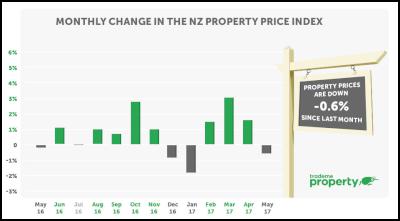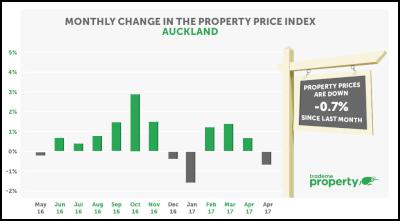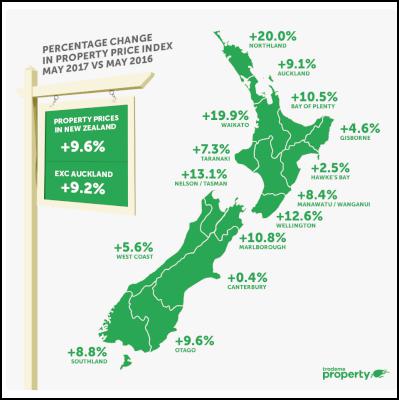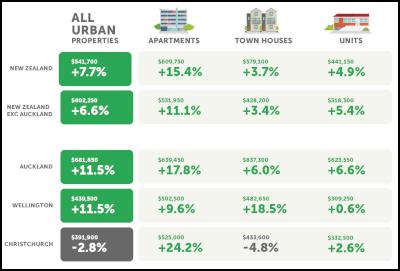The brakes are being applied to the NZ property market
The brakes are starting to be put on the New Zealand property market as the average asking price for the typical Kiwi property dropped 0.6 per cent in May compared to April, according to the latest Trade Me Property Price Index. .
Head of Trade Me Property Nigel Jeffries said the average asking price was $640,650 in May. “Asking prices are still up almost 10 per cent on a year ago, but we’re seeing signs that a slowdown is starting.
“There’s no need for homeowners to worry, the market is still doing exceptionally well, but buyers will be pleased to see that the rate of growth appears to be easing back.”

Auckland slowing the fastest
Mr Jeffries said the Auckland market is experiencing a more significant slowdown than the rest of the country with the average asking price in the City of Sails dipping 0.7 per cent in May to $919,000.
“The Auckland market first broke through the $900,000 ceiling back in November last year and since then the average asking price has hovered around the $915,000 mark. It has been a bit stagnant compared to the powerful market of the past few years when prices blasted from $700,000 to $800,000 in just 10 months back in 2015, and then leapt from $800,000 to $900,000 the following year.”
“The way things were going we’d expected to see prices closer to the $1m mark by now, but the LVRs and other restrictions appear to have slowed the Auckland market right down.”

All regions in positive territory
Mr Jeffries said for the first time since Trade Me began recording average asking prices back in 2008, all 15 regions of the country had increased year-on-year. “This is especially significant in regions such as the West Coast which has declined in 10 of the past 18 months and Canterbury which has returned to positive growth in May after four consecutive months of declining asking prices.
“While we’re seeing some easing in property prices - it’s fair to say the New Zealand property market is enjoying strong growth. Seeing positive growth for every region compared to May 2016 is amazing and not something we expect to see very often.”
The average asking prices in Auckland’s ‘halo regions’ continue to grow at well over 10 per cent. Waikato (up19.9 per cent) hit another record high of $525,550 and up over $87,000 in the past year alone. The region has seen an eye-popping rise of over $164,000 over the past three years.
Northland and Bay of Plenty have grown strongly too, up 20 and 10.5 per cent respectively. The average asking price in the Bay of Plenty has risen 43 per cent in the last three years, adding $178,250 to the cost of buying the typical property which now sits at $589,550.

Large houses illustrate the Auckland market perfectly
Large houses (5+ bedrooms) have been very popular with buyers in Auckland over the last three years. The average asking price for these houses has jumped 44 per cent in the last three years.adding $435,000 to land at $1,428,950 in May.
Despite these gains, Mr Jeffries said large houses are a perfect example of the slowing Auckland market. “Back in June 2014 the average asking price for house with 5 or more bedrooms broke the $1m mark.
“Ten months later it jumped from $1m to $1.1m, before hitting $1.4m in October 2016. Since then prices of large houses in Auckland have been hovering between $1.38m and a high of $1.44m as the market looks to head into a holding phase.”
Table 1: Average asking price by property size & region, May 2017 vs May 2016

Units still firm favourite for buyers
While the Auckland property market is showing signs of easing, units have bucked the trend.
In May the expected selling price of units in Auckland reached a new record high of $623,550, after increasing by 6.6 per cent in the last year.
“The humble unit in Auckland has doubled in price in less than seven years. Back in September 2010, a unit had an average asking price of $310,200. Over the same period, the average asking price for a similar sized house in Auckland has risen by 88 per cent or $315,000. Only apartments in Auckland have risen faster, up a massive 136 per cent over the same period.”.”
Table 2: Average asking price by property type & region, May 2017 vs May 2016



 The Future Is Rail: Ferry Decision - Common Sense Prevails
The Future Is Rail: Ferry Decision - Common Sense Prevails Aotearoa Food Rescue Alliance: Grocery Market Reform Must Include Mandatory Food Rescue Partnerships
Aotearoa Food Rescue Alliance: Grocery Market Reform Must Include Mandatory Food Rescue Partnerships Hugh Grant: Zero Trust Security - A Buzzword Or The Ultimate Protection?
Hugh Grant: Zero Trust Security - A Buzzword Or The Ultimate Protection? Bill Bennett: Comcom revisits fibre rules as competition intensifies
Bill Bennett: Comcom revisits fibre rules as competition intensifies Bill Bennett: Download Weekly Extra - InternetNZ disrupted
Bill Bennett: Download Weekly Extra - InternetNZ disrupted Community Housing Aotearoa: Reducing Debt Financing Barriers For Community Housing Providers
Community Housing Aotearoa: Reducing Debt Financing Barriers For Community Housing Providers



